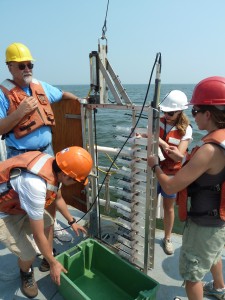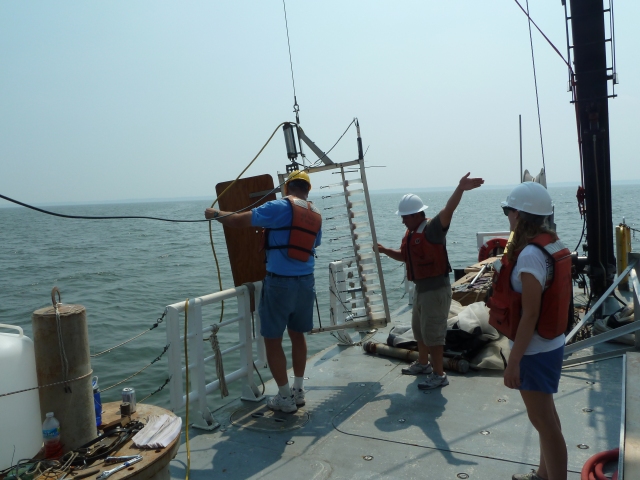Today we had a nice visit from our friends that are working on the LiDZ project, as well as a few other visitors. It was a pleasant diversion from our standard operating procedure but it also meant we had to exchange two of our science team for two others. The reason is simply because the ship is at capacity, as is our lab. We have two teachers and two undergrads working on science and education projects through the COSEE Coast Trends program. More on that later, but suffice it to say that we’ve got lots of able bodies and not enough beds, so we had to do a transfer. Our LiDZ colleagues brought the new folks out and took the departing scientists back, but while they were out there they took some samples and raided the ice cream fridge. We’ll miss our departing folks, but have some strong, fresh team members coming off the bench!
What samples did the LiDZ folks take? Why, I’m so glad you asked! They brought out a “syringe sampler” that can take multiple small water samples simultaneously over a 1.5 m range. It works by installing a series of syringes on an aluminum frame. The plungers are closed when they are installed, and a piece of line is tied from the plunger to a rotating bar. When the gizmo reaches the required depth, a motor is activated that winds the strings up on the bar, pulling the syringe plungers, which pulls water in.
It’s a very useful tool to have if you are looking for chemical and biological gradients in the water, which is something we are keenly aware of for this project. It would not sample my beloved copepods very well – they would just swim away – but it likely samples copepod food pretty well. What I’m talking about are the small single-celled organims that either photsynthesize (= phytoplankton or algae) or eat other single-celled organisms ( = microzooplankton). The water can also be sampled for chemical compounds, and this group is the team to do that. They are looking for gradients in nutrients like nitrate, nitrite, ammonia, and phosphorous, but also other chemicals such as dissolved oxygen and metals such as iron and manganese. Samples were also taken to examine the bacterial communities that exist across these small gradients, to see how different or similar they are.
To figure out how to make this thing most useful for our science goals, we first huddled around the CTD screen to see what the water properties looked like. Then, the group figured out what depth would have the strongest and most interesting gradient to sample. What they were looking for was a region of the water where things change fast – where oxygen decreases quickly over very small changes in depth, for example. Then, they picked a spot that would include the lowest, anoxic water in their deepest syringe samples but would have oxygenated water in the highest samples, and sent it over. Once it got to the desired depth – determined by a counter on the winch that reports how much wire is out, as well as a sensor at the top of the instrument that give readings of temperature, salinity, oxygen, fluorescence, and depth – the motor is started, which opens the syringes. Then it’s brought back and samples are taken.
We won’t know for a while what they found, but we can be sure that it was worth their trip. Stay tuned for updates from the hot and sticky ship as we work to unravel the mysteries of the Chespeake Bay zooplankton.



